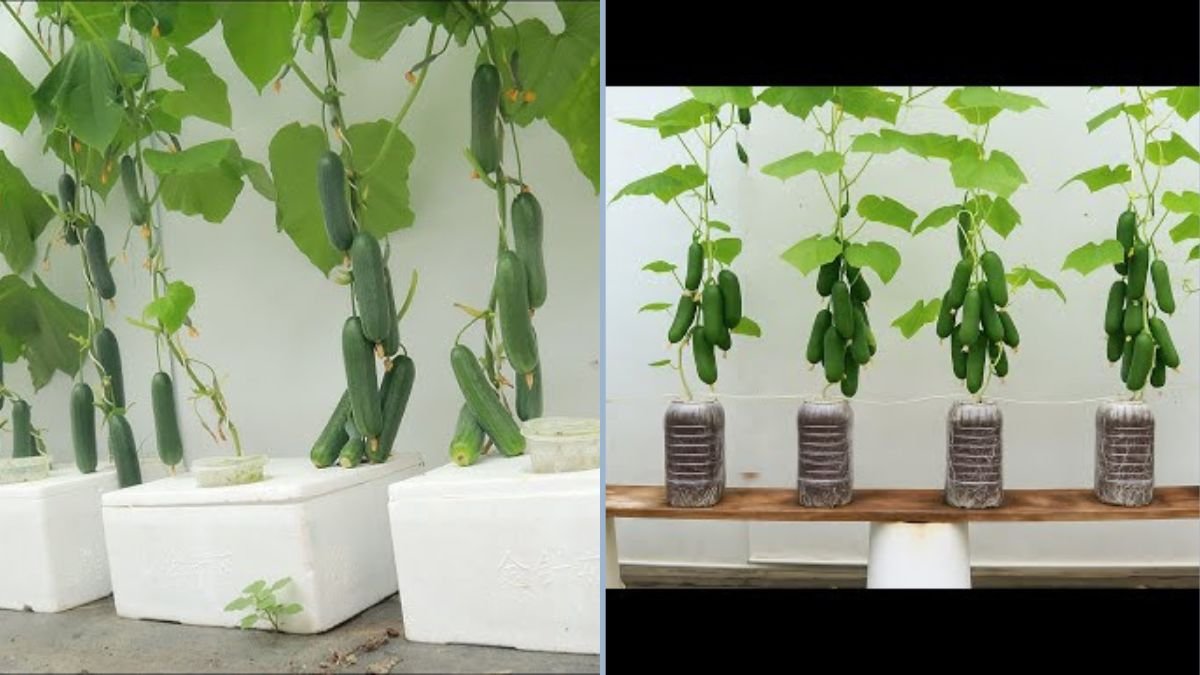Cucumbers are one of the most refreshing and versatile vegetables in the kitchen. From salads to pickles, smoothies to sandwiches, they add crunch, hydration, and nutrition to our meals. Traditionally, cucumbers are grown in gardens, requiring soil, space, and regular maintenance. But what if you don’t have a garden? Thanks to a viral growing method using simple water bottles, anyone can now cultivate cucumbers at home—even on a balcony, terrace, or windowsill. This innovative method is eco-friendly, space-saving, and surprisingly effective, and it’s rapidly gaining popularity online. In this comprehensive guide, we’ll explore how to grow cucumbers in water bottles, step by step, for a bountiful harvest.
Why Grow Cucumbers at Home
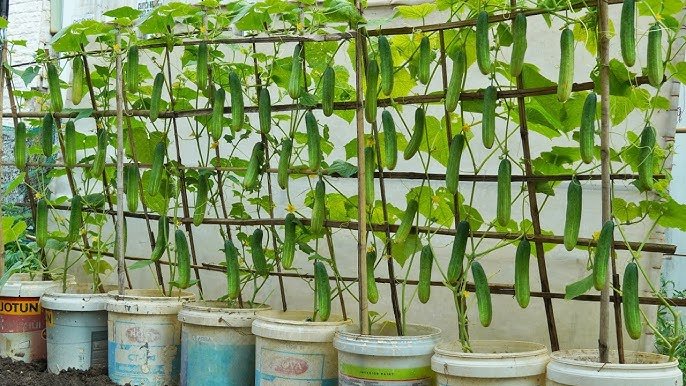
There are many benefits to growing cucumbers at home:
- Freshness: Homegrown cucumbers are crisp, flavorful, and free from harmful chemicals.
- Cost savings: Avoid purchasing cucumbers from the store, which can quickly add up.
- Convenience: Grow cucumbers wherever you have space—balcony, kitchen counter, or even indoors.
- Sustainability: Reusing plastic bottles as planters reduces waste while creating a mini-garden.
- Educational and fun: Perfect for children and adults to learn about plant growth, water cycles, and sustainability.
With this method, even apartment dwellers or urban gardeners can enjoy the benefits of homegrown cucumbers.
Why Water Bottles Work
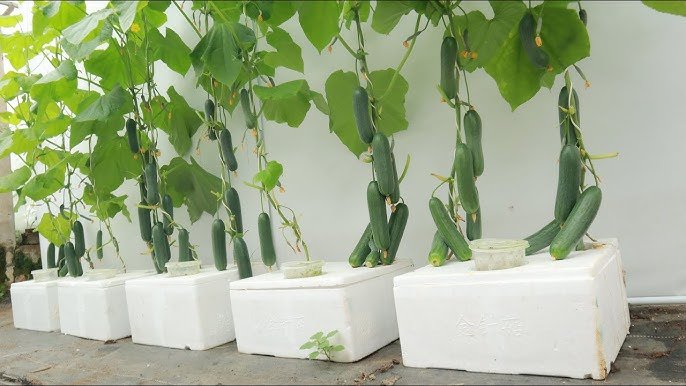
Water bottles are not just containers—they are surprisingly effective for cucumber cultivation:
- Recycling: Repurpose plastic bottles to reduce environmental impact.
- Controlled environment: Water bottles act as self-contained planters, making watering and nutrient management easier.
- Space-saving: Vertical arrangements allow you to grow multiple plants in small areas.
- Mobility: Move bottles to follow sunlight or protect from extreme weather.
The water bottle method turns a simple container into a productive mini-garden, perfect for anyone without a traditional garden space.
Choosing the Right Cucumber Variety
Not all cucumbers are ideal for container growing. Choosing the right variety ensures higher yields and healthier plants:
- Bush varieties: These compact plants are perfect for small containers. Examples include ‘Bush Champion’ or ‘Spacemaster.’
- Vining varieties: Ideal for vertical arrangements using a trellis. Examples include ‘Marketmore’ or ‘Japanese cucumber.’
- Pickling cucumbers: Smaller cucumbers suited for salads or pickling can also thrive in bottles.
Selecting a variety that matches your space and intended use is essential for success.
Materials Needed
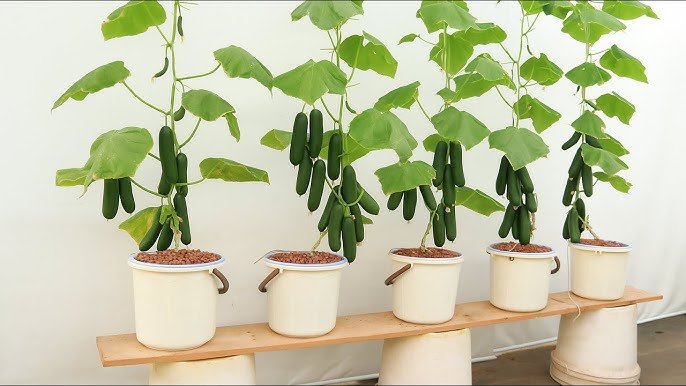
To grow cucumbers in water bottles, you’ll need a few simple materials:
- Plastic bottles: 1–2 liter bottles work best.
- Potting mix or coco peat: Light, well-draining media to support roots.
- Cucumber seeds or seedlings: Choose a high-germination variety.
- Water: For maintaining moisture and occasional nutrient solutions.
- Scissors or utility knife: To cut the bottles and create drainage.
- Trellis or sticks: For supporting vining varieties.
These everyday materials allow you to create an effective growing system with minimal cost.
Step 1: Preparing the Bottles
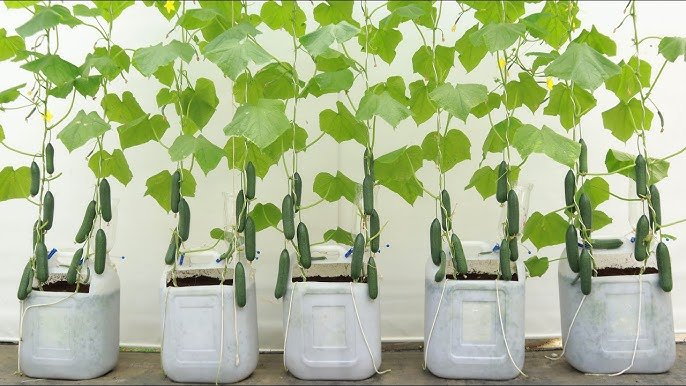
Proper preparation of your water bottles is crucial:
- Clean bottles thoroughly to remove any dirt or residues.
- Cut the bottle: Remove the top 1/3 of the bottle to create an opening for planting and easy access.
- Create drainage: Poke 2–3 small holes at the bottom to prevent waterlogging.
- Optional reservoir method: For a self-watering system, cut the bottle in half and invert the top portion into the bottom half, creating a wicking system for consistent moisture.
Well-prepared bottles provide an ideal environment for cucumber roots to grow.
Step 2: Adding Soil and Planting Seeds
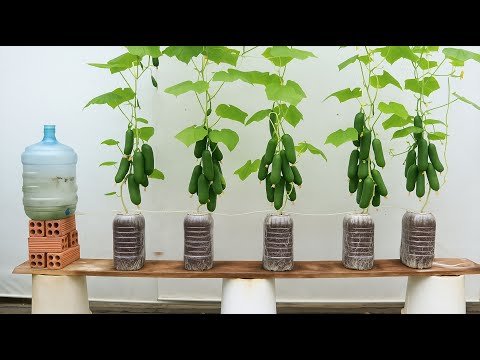
Next, it’s time to add soil and plant your seeds:
- Fill the bottle with a lightweight, well-draining potting mix or coco peat, leaving 2–3 cm of space at the top.
- Plant seeds 1–2 cm deep and gently cover with soil.
- Water lightly to settle the soil around the seeds.
- Label your bottles if planting multiple varieties to track growth.
Proper planting ensures seeds germinate evenly and reduces the risk of disease.
Step 3: Providing Support for Growth
Cucumbers are climbers and need support to grow vertically:
- Trellises or sticks: Place a small trellis or bamboo stick in each bottle for vining varieties.
- Twisting vines: As vines grow, gently guide them around the support.
- Preventing breakage: Use soft ties or clips to secure vines without damaging stems.
Vertical growth maximizes space, improves airflow, and keeps fruits off the soil, reducing rot and pests.
Step 4: Watering and Nutrients
While water bottles reduce the need for frequent watering, proper moisture is still key:
- Water regularly: Keep soil evenly moist but avoid overwatering. The bottom drainage ensures roots don’t sit in water.
- Nutrient solutions: Occasionally add a diluted liquid fertilizer or compost tea to support growth.
- Monitor for dryness: Check soil every few days, especially in warm or dry conditions.
Consistent care ensures robust growth and high-quality cucumbers.
Step 5: Sunlight Requirements
Cucumbers require ample sunlight to thrive:
- Direct sunlight: 6–8 hours per day is ideal for healthy growth.
- Indoor placement: Place bottles near windows or under grow lights if natural sunlight is insufficient.
- Rotate bottles: Move them periodically to ensure all sides receive light.
Proper sunlight encourages flowering, fruit set, and prevents leggy growth.
Step 6: Pollination
Cucumbers produce separate male and female flowers. Successful pollination ensures fruit development:
- Natural pollinators: Bees and other insects help transfer pollen outdoors.
- Hand pollination: Indoors, use a small brush or cotton swab to transfer pollen from male to female flowers.
- Timing: Pollinate flowers in the morning when they are open and receptive.
Pollination is critical for a consistent cucumber harvest in any growing environment.
Step 7: Harvesting Cucumbers
Knowing when and how to harvest ensures peak flavor and quality:
- Timing: Cucumbers are usually ready 50–70 days after planting, depending on the variety.
- Size: Harvest when fruits reach desired size, generally 15–20 cm for slicing varieties.
- Technique: Use a sharp knife or scissors to cut the cucumber from the vine, leaving a small portion of the stem attached.
Regular harvesting encourages the plant to continue producing new fruits, maximizing yield.
Benefits of Growing Cucumbers in Bottles
- Space efficiency: Grow multiple plants vertically, even in tiny spaces.
- Reduced maintenance: Less watering and soil preparation compared to traditional gardening.
- Eco-friendly: Reuse plastic bottles and reduce household waste.
- Educational: Great for teaching children about plant growth and sustainability.
- Fresh produce: Enjoy homegrown cucumbers free from chemicals year-round.
This method makes cucumber cultivation accessible, fun, and productive for anyone.
Tips for Maximizing Yield
- Stagger planting: Plant seeds every 2–3 weeks for continuous harvest.
- Prune leaves and side shoots: Encourage healthy airflow and prevent overcrowding.
- Rotate nutrients: Add compost tea or diluted organic fertilizer every 2–3 weeks.
- Protect from pests: Check for aphids or mites and treat organically if needed.
- Support vining properly: Avoid broken stems by securing vines gently.
Following these tips ensures a successful, high-yield mini cucumber garden.
Conclusion
You don’t need a garden to enjoy fresh, homegrown cucumbers. With a few plastic bottles, potting mix, and basic care, anyone can grow cucumbers successfully, whether on a balcony, terrace, or indoor space. This method has taken the internet by storm—and for good reason. It’s cost-effective, eco-friendly, space-saving, and highly productive.
By following these simple steps—preparing bottles, planting seeds, providing support, maintaining moisture and nutrients, ensuring sunlight, and proper pollination—you can enjoy crisp, nutritious cucumbers right at home. Regular harvesting encourages continuous growth, allowing you to enjoy fresh cucumbers all year round.
Whether you are a seasoned gardener or a beginner, growing cucumbers in bottles is an innovative and rewarding way to bring gardening into your home without the need for a traditional garden. Start today and experience the joy of growing your own fresh, flavorful cucumbers anywhere!
